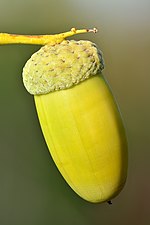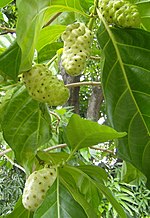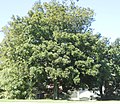Phenology is the study of periodic events in biological life cycles and how these are influenced by seasonal and interannual variations in climate, as...
45 KB (4,945 words) - 04:16, 20 November 2024
vegetation greenness in North America. Climate-induced shifts in the phenology of seasonal resource availability can cause mismatches between the timing...
99 KB (11,250 words) - 18:19, 10 November 2024
Plant Phenology Ontology (PPO) is a collection of OBO Foundry ontologies that facilitate integration of heterogeneous data about seed plant phenology from...
13 KB (1,532 words) - 02:21, 17 July 2024
an online phenology research and education project for 4–18-year-olds in the UK. It is run by the Woodland Trust, as part of the UK Phenology Network....
1 KB (163 words) - 19:52, 25 August 2020
Climate change and birds (section Phenology)
likely miss the time for resource gathering. In response, changes in bird phenology have been observed over the past 50 years, such as the lengthening of...
47 KB (7,177 words) - 07:50, 9 October 2024
species for details of oak classification, in which acorn morphology and phenology are important factors. The word acorn (earlier akerne, and acharn) is...
26 KB (2,912 words) - 19:50, 8 November 2024
Morinda citrifolia (section Phenology)
Morinda citrifolia is a fruit-bearing tree in the coffee family, Rubiaceae, native to Southeast Asia and Australasia, which was spread across the Pacific...
20 KB (2,015 words) - 14:30, 6 September 2024
Cleome viscosa (section Phenology)
Cleome viscosa, the Asian spiderflower or tick weed is an annual herb that grows up to a meter high. It belongs to the family Cleomaceae. It is considered...
6 KB (745 words) - 18:32, 11 April 2022
(July 1984). "Egg-laying patterns in butterflies in relation to their phenology and the visual apparency and abundance of their host plants". Oecologia...
155 KB (16,853 words) - 17:40, 18 November 2024
Quercus lyrata (section Phenology)
Quercus lyrata, the overcup oak, is an oak in the white oak group (Quercus sect. Quercus). The common name, overcup oak, refers to its acorns that are...
11 KB (1,327 words) - 02:07, 27 July 2024
(GDD), also called growing degree units (GDUs), are a heuristic tool in phenology. GDD are a measure of heat accumulation used by horticulturists, gardeners...
13 KB (1,479 words) - 19:24, 10 July 2024
Badumna longinqua (section Phenology)
Badumna longinqua or the grey house spider is a species of spiders in the family Desidae. Native to eastern Australia, it has been introduced into New...
17 KB (1,863 words) - 08:32, 18 August 2024
Leccinellum lepidum is a species of bolete in the family Boletaceae. Originally described as Boletus lepidus in 1965, the fungus has gone through controversial...
19 KB (1,989 words) - 02:51, 15 May 2024
changes affect ecosystem function and productivity. For example, plant phenology can be a useful proxy for temperature in historical climatology, and the...
138 KB (14,773 words) - 09:08, 30 October 2024
Miliusa velutina (section Phenology)
Miliusa velutina is a flowering plant belonging to the family Annonaceae, native to parts of Asia from India in the west to Vietnam in the east. കാനക്കൈത...
2 KB (154 words) - 08:30, 17 November 2024
Idiospermum (section Phenology)
Idiospermum is a monotypic genus (that is, a genus that contains only one species) in the family Calycanthaceae. The sole included species is Idiospermum...
20 KB (2,280 words) - 04:39, 30 July 2024
Hymenosporum (section Phenology)
Hymenosporum is a monotypic genus of trees in the family Pittosporaceae. The sole included species is Hymenosporum flavum, commonly known as native frangipani...
9 KB (825 words) - 03:40, 7 January 2024
Sedum sekiteiense (section Description and phenology)
Sedum sekiteiense is a Taiwan-endemic species of the family Crassulaceae in the Sedum genus. It is also one of the few wild plants named after Shiding...
6 KB (870 words) - 22:27, 5 April 2024
Alectryon excelsus (section Life cycle/phenology)
Alectryon excelsus, commonly known as tītoki, or sometimes New Zealand oak, is a shiny-leaved tree native to New Zealand. It is in the family Sapindaceae...
8 KB (929 words) - 02:32, 28 August 2024
Tuberolachnus salignus (section Life Cycle/Phenology)
Tuberolachnus salignus, or the giant willow aphid, is a species of aphid, in the genus Tuberolachnus. They are reputed to be the largest aphids, with a...
19 KB (1,976 words) - 04:50, 6 August 2024
Rubus queenslandicus (section Phenology)
Rubus queenslandicus, commonly known as bramble-of-the-cape, rose-leaf bramble, or native raspberry, is a plant in the rose family Rosaceae which is endemic...
8 KB (732 words) - 09:12, 5 September 2024
Tuber melanosporum (section Development and phenology)
Tuber melanosporum, called the black truffle, Périgord truffle or French black truffle, is a species of truffle native to Southern Europe. It is one of...
23 KB (2,556 words) - 21:41, 5 November 2024
Holigarna arnottiana (section Phenology)
Holigarna arnottiana is a deciduous tree belonging to family Anacardiaceae. This tree is distributed along South West parts of India and is endemic to...
3 KB (284 words) - 08:54, 6 November 2024
Ryparosa kurrangii (section Phenology)
Ryparosa kurrangii is a rare plant in the family Achariaceae which is endemic to a very small part of the Queensland tropical rain forests. It is a small...
10 KB (929 words) - 09:11, 5 September 2024
Chinese calendar (section Phenology)
Early calendar systems often were closely tied to natural phenomena. Phenology is the study of periodic events in biological life cycles and how these...
91 KB (9,601 words) - 01:44, 18 November 2024
Drymoanthus adversus (section Phenology)
Drymoanthus adversus is an orchid species endemic to New Zealand. The plant morphology of Drymoanthus adversus resembles a small cluster of spider plants...
13 KB (1,624 words) - 21:45, 5 August 2024
Buchanania axillaris (section Phenology)
Buchanania axillaris, the Cuddapah almond or Buchanan's mango, (മലയാളം: കുളമാവ്) is a species of flowering plant in the family Anacardiaceae. The native...
3 KB (283 words) - 10:25, 16 November 2024
The red-sided garter snake (Thamnophis sirtalis parietalis) is a subspecies of the common garter snake, in the subfamily Natricinae of the family Colubridae...
20 KB (2,409 words) - 02:09, 3 June 2024
Cycnogeton procerum (section Phenology)
Cycnogeton procerum (formerly Triglochin procera), is an aquatic plant species in the family Juncaginaceae. It is commonly referred to as 'water ribbons'...
5 KB (432 words) - 07:30, 17 November 2024

























